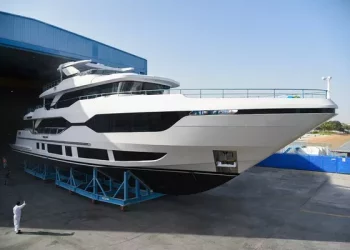Flight icing can cause a lot of problems and even disasters for aircraft flying, so what can be done to stop icing?
Since the emergence of air accidents caused by flight icing, humans have begun to study flight anti-icing and de-icing.
As the name suggests, anti-icing means to prevent flight icing, that is, it is not allowed to produce ice during the flight;
Deicing means to remove ice formed during flight, that is, to allow a certain degree of icing during flight that will not seriously affect flight safety.
So when to de-ice and when to de-ice?
Anti-icing is generally aimed at some parts whose icing will seriously affect flight safety. When icing environmental conditions are detected during flight, anti-icing system is started to anti-icing components to prevent icing phenomenon on the surface of components.
Deicing is generally set for some parts that allow a small amount of icing without affecting flight safety. These parts can allow a moderate amount of ice accumulation. When the amount of icing reaches the deicing standard, the deicing system will be opened for deicing to remove the icing on the outer surface, and then the deicing system will be closed.
The commonly used anti-icing and deicing methods of aircraft include mechanical deicing system and heated anti-icing/deicing system.
Mechanical deicing system is a deicing device that depends on the action of mechanical force to remove ice on the surface, including pneumatic belt deicing and electrical pulse deicing.
Pneumatic belt deicing system is by filling the expansion tube with compressed air to expand it, so that the surface ice broken off to achieve the purpose of deicing;
The electric pulse deicing system uses the high energy electric pulse to act on the skin of the deicing part, so that the skin produces a kind of vibration with small amplitude but high frequency, so as to achieve the purpose of deicing.
Heated anti-icing system is the most common anti-icing system in use at present.
According to the heating source, it can be divided into hot gas anti-icing system, electric heating anti-icing system and heating anti-icing system using other heat sources.
The hot air anti-icing system is the most widely used anti-icing system at present. The hot air comes from the compressor air of the engine.
When the anti-icing system is opened, the bleed valve is opened, and the hot air flows through the corresponding pipeline to the inner side of the parts that need anti-icing to heat the parts, so as to achieve the purpose of anti-icing.
Electro-thermal anti-icing systems also prevent/deice the components by heating them, but the heat source is converted through electrical energy.
The electric heating anti-icing/deicing system does not need to arrange complex air intake pipelines like the hot air anti-icing system, nor does it need to consider the design of the flow passage during heating. Therefore, the system layout is relatively simple, and it is easy to realize the effective control of heating power, and the anti-icing/deicing mode can be set according to the actual situation.
In addition, due to the small size of some aero-engine parts, some also use hot lubricating oil to provide anti-icing heat for their anti-icing. Usually, this kind of system will introduce the high temperature return oil of the engine into the inner flow channel of the parts that need anti-icing, and reduce the temperature of the lubricating oil at the same time, which can be said to kill two birds with one stone.
The anti-icing/deicing methods described above are mature, but they all have their own disadvantages.
Researchers are still trying to find new anti-icing/deicing systems, such as superhydrophobic surface coating anti-icing technology, microwave anti-icing technology, and ultrasonic anti-icing technology.
The meteorological conditions, flight parameters and component structures that affect the icing of aircraft and engines have been understood to some extent. However, the icing of aircraft and engines is a very complicated problem due to the fact that icing is affected by many factors.
In recent years, there are many new hot spots to be solved about the icing problem of aircraft, such as the icing problem caused by large excess cold water droplets, the icing problem caused by the overflow water of incomplete evaporation system, and the icing problem caused by the internal parts of the engine under ice crystal climate conditions.
The impact of large overcooled water droplets on the surface of the aircraft will form complex impact behaviors such as water droplets’ rupture, splashing, and reattachment, which makes the icing mechanism and icing ice type of the aircraft more complex, thus bringing difficulties to the design of the aircraft anti-icing system.
Ice crystals that exist in the clouds hit the wings won’t produce icing phenomenon, but the connotation of the ice crystals in the engine because of the high temperature compressed air after heating, the ice will melt the connotation of the fan after the rotor part and static ice adhesion on child widgets, causing serious engine stall and surge of failure.
In recent years, researchers have carried out a lot of research on the icing mechanism of large water droplets and ice crystals in the engine.
Aircraft icing is a complex phenomenon in which supercooled water droplets collide on the aircraft surface and undergo phase transition.
Around aircraft icing, and the problems faced in recent years our country scientific research personnel in the plane of ice formation mechanism, the formation regularity and characteristics of ice, ice caused by abnormal aerodynamics and flight mechanics characteristics and its influence on flight safety, and freeze protection theory and method, the ground simulation test and flight test was carried out by a lot of research work,
Many gratifying results have been achieved.
As the mechanism of formation of the ice, ice to the plane of aerodynamics and flight mechanics coupling effect and its mechanism of endangering flight safety and control mechanism of ice in the process of complex physical scientific questions more in-depth research, researchers will put forward more advanced theory and methods of anti-icing and deicing, more to ensure that the aircraft flight safety in icing conditions.
The latest market dynamics at any time to see, please pay attention to.












































